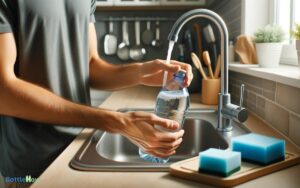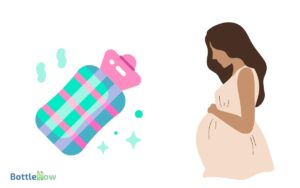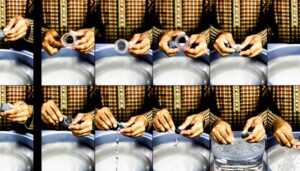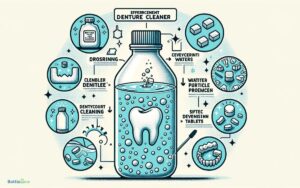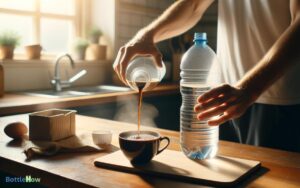How Many Ounces in a Water Bottle Cap? 0.17 Ounces!
A standard water bottle cap typically holds about 0.17 ounces of liquid. Most caps measure between 1 to 1.5 inches in diameter and are made from durable materials like HDPE or PP.
The capacity can vary based on factors like threading type and seal integrity, but it commonly falls within the 0.5 to 1-ounce range.
Screw-on caps offer the most secure seal, while flip-top and sports caps cater to specific functionalities.
When using caps as DIY measuring tools, guarantee consistency by calibrating your measurements. For an in-depth look at using bottle caps for precise measurements, stay tuned.
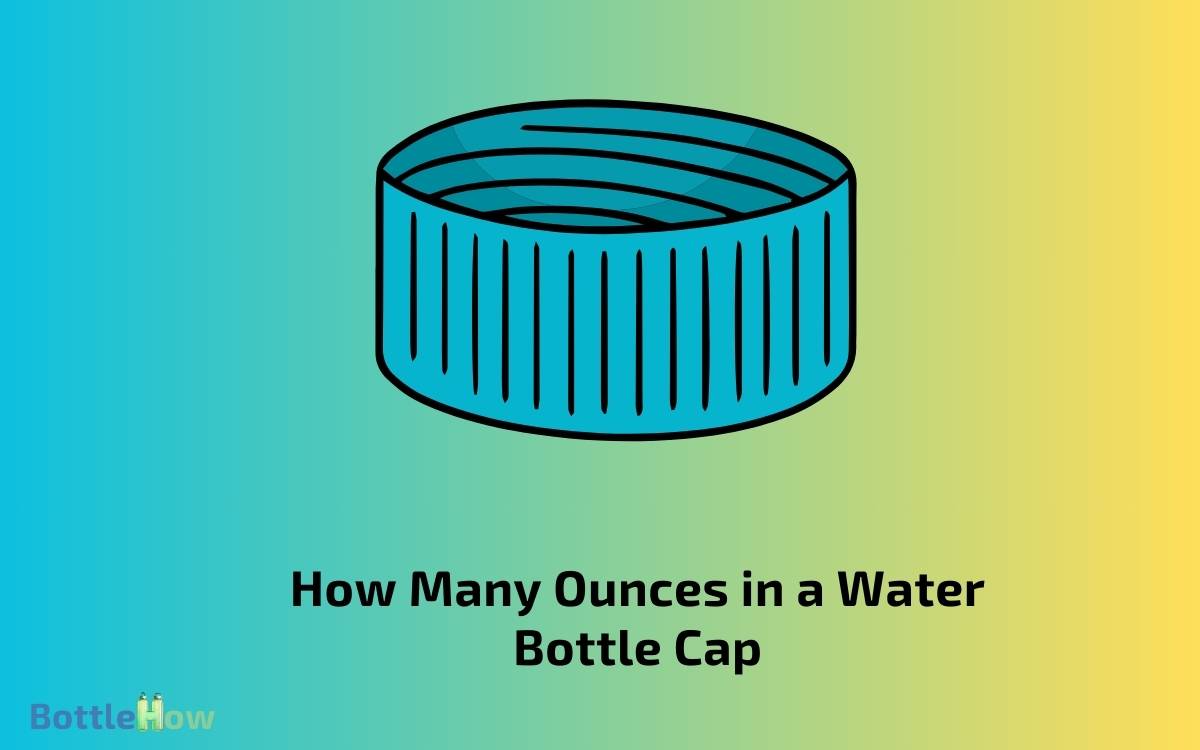
Key Takeaways
Understanding Volume Measurements
To accurately determine how many ounces a water bottle cap holds, it’s crucial to understand the fundamental principles of volume measurements.
First, you’ll need to grasp the concept of fluid ounces, a unit commonly used in the United States to measure liquid volume.
One fluid ounce equals approximately 29.5735 milliliters. Using a graduated cylinder or a precise measuring cup, you can fill the cap with water and then pour it into the measuring tool to read the volume.
Make sure there are no air bubbles to get an accurate measurement. Repeat this process several times for consistency.
Understanding these principles ensures that your determination of the cap’s volume is accurate and reliable, providing a solid foundation for further calculations.
Average Size of Water Bottle Caps
You’ll find that water bottle caps typically measure around 1 to 1.5 inches in diameter, influencing their volume capacity. Most caps hold between 0.5 to 1 ounce of liquid, depending on their design and material.
Factors like threading type and seal integrity also play an essential role in their overall functionality and capacity.
Standard Cap Dimensions
A standard water bottle cap typically measures about 1 inch in diameter and can hold approximately 0.17 ounces of liquid.
You’ll find that the dimensions of these caps are quite consistent across various brands due to industry standards.
The internal threading on the cap guarantees a secure fit on the bottle, preventing leaks. The outer surface often features ridges or textured patterns, providing you with a better grip. This uniformity in size and design aids in manufacturing efficiency and consumer usability.
When you’re dealing with measurements, remember that the slight variations in cap dimensions can slightly alter capacity, but the difference is generally negligible.
Understanding these dimensions can help you precisely gauge liquid volumes in practical scenarios.
Common Volume Capacity
Given the standard dimensions, a typical water bottle cap can hold approximately 0.17 ounces of liquid, making it a reliable unit for small volume measurements.
You’ll find this useful when you need precise liquid quantities for tasks like diluting solutions or following specific recipes.
The design of most water bottle caps, engineered for uniformity, guarantees this consistency in volume. It’s crucial to recognize that the slight variations in cap sizes across different brands generally don’t impact the average volume capacity greatly.
When measuring liquids using a water bottle cap, make sure it’s filled to the brim for accuracy. This capacity, though seemingly modest, can be incredibly practical in scenarios demanding precision and control over small liquid quantities.
Material and Design Factors
Many water bottle caps are made from high-density polyethylene (HDPE) or polypropylene (PP), materials chosen for their durability and resistance to various chemicals.
You’ll find that these materials guarantee the cap’s longevity and maintain a strong seal, preventing leaks.
The design of a water bottle cap typically adheres to standard dimensions, usually around 1 to 1.5 inches in diameter. This size accommodates various bottle types while optimizing user convenience.
Additionally, the threading inside the cap is precision-engineered to match the bottle’s neck, ensuring a secure fit.
The average cap, when filled, holds approximately 0.5 to 1 fluid ounces of liquid, depending on its exact shape and size. Understanding these factors aids in evaluating their practical use and efficiency.
Types of Water Bottle Caps
Water bottle caps come in various types, including screw-on, flip-top, and sports caps, each designed for specific functionality and user convenience.
Screw-on caps provide a secure seal, making them ideal for preventing leaks. Flip-top caps offer convenience for quick access, perfect for on-the-go hydration.
Sports caps are engineered for easy one-handed operation, favored by athletes for their efficiency during workouts.
Here’s a quick overview:
| Cap Type | Key Feature | Best For |
|---|---|---|
| Screw-on | Secure seal | Leak prevention |
| Flip-top | Quick access | On-the-go use |
| Sports | One-handed use | Athletic activities |
Understanding these types helps you choose the right cap for your needs, ensuring both convenience and functionality.
Common Uses for Bottle Caps
Beyond their primary function of sealing bottles, caps can serve a variety of practical and creative uses in everyday life. You’ll find that these small, often overlooked items can be quite versatile.
For instance, they can be repurposed in numerous ways, contributing to both household functionality and creative projects.
- Organizers: Use caps to sort and store small items like beads, screws, or pins.
- Craft Projects: Incorporate them into art projects, such as mosaics or DIY jewelry.
- Game Pieces: Repurpose them as makeshift tokens for board games or educational activities.
- Furniture Leveling: Place them under wobbly furniture legs to stabilize and balance.
Measuring Liquid With Bottle Caps
A standard water bottle cap typically holds about 0.5 to 1 ounce of liquid, making it a convenient tool for quick, small-volume measurements.
You can use this everyday item to measure out specific amounts of liquid, ideal for tasks where precision isn’t critical.
For example, if you need to add a small amount of water to a recipe or a mixture, the cap serves as a handy measuring unit. It’s especially useful in situations where traditional measuring tools aren’t accessible.
Just keep in mind, variations in cap sizes can slightly alter the volume they hold. Hence, it’s a good idea to first test the capacity of your specific bottle cap by filling it with a known volume of liquid.
How to Measure Accurately
To measure accurately using a bottle cap, first make sure that you calibrate it by filling it with a known volume of liquid, such as from a measuring cup. This baseline guarantees that your measurements are consistent.
- Use a precise measuring cup: Start with a reliable measuring tool to establish your baseline.
- Mark the cap: Once filled, mark the liquid level on the cap with a permanent marker.
- Repeat the process: Verify your initial measurement by repeating the filling process multiple times.
- Maintain consistency: Always use the same method and tools to avoid discrepancies.
Comparing Different Brands
When comparing different brands of water bottles, you’ll notice that the cap size and design can vary greatly, affecting the volume it can hold.
For instance, brands like Nalgene often feature larger caps that can hold more liquid, typically around 1.5 ounces.
Conversely, brands such as Dasani or Aquafina have smaller, narrower caps, holding closer to 0.5 ounces.
The material and threading also impact the capacity; thicker plastic caps might displace more liquid, reducing their effective volume. Understanding these differences is essential for precise measurements.
Always consider the brand’s specifications, as they can provide valuable insights into the cap’s volume, ensuring you get accurate and reliable data across various water bottle brands. Additionally, referring to a water bottle size chart can help you compare different capacities and choose the most suitable option for your needs. This ensures consistency when measuring liquids and prevents any miscalculations caused by variations in cap sizes. By combining brand specifications with a water bottle size chart, you can make informed decisions and maintain accuracy across different bottles.
Practical Applications
Understanding the exact volume a water bottle cap can hold has practical applications in various fields.
In pharmaceuticals, the cap is used for precise dosage measurements to avoid over or under-medicating. This is crucial for ensuring accurate medication administration.
In cooking, the cap aids in adding precise amounts of ingredients, particularly when dealing with potent extracts or concentrated flavors.
This helps maintain recipe consistency. Scientific research also benefits from using the cap for controlled liquid measurements in experiments to introduce variables accurately, ensuring experiment validity.
In addition to these fields, the water bottle cap can also be useful in home DIY projects. It provides a simple and accessible means of liquid measurement without the need for specialized tools.
DIY Measuring Tools
For crafting DIY measuring tools, you’ll need to repurpose everyday items like water bottle caps, which can provide reliable and precise measurements with a bit of calibration.
Start by filling the cap with water and using a graduated cylinder or a standard measuring spoon to determine its volume. Once you’ve established the exact measurement, mark the cap for future reference.
You can also use multiple caps to create a set of varying volumes. Keep in mind that consistency is key, so always use the same type of cap.
This method offers a quick and cost-effective solution for measuring small quantities, making it ideal for cooking, gardening, or any other task requiring precise measurements.
Scientific Approach
When you approach measuring the ounces in a water bottle cap scientifically, you need to prioritize precision, utilizing laboratory measurement tools like graduated cylinders or pipettes.
Emphasizing the importance of distinguishing between accuracy, which refers to how close your measurement is to the true value, and consistency, which indicates how repeatable your measurements are.
Employing these principles guarantees reliable and valid results in your measurements.
Precision in Measurement
Why is precision in measurement essential when determining the exact volume of a water bottle cap?
Precision guarantees accurate and reproducible results, which are critical for scientific integrity and practical applications.
When you measure the volume precisely, you can avoid discrepancies that might arise from human error or equipment limitations.
Here are some key reasons why precision matters:
- Reproducibility: Accurate measurements allow you to replicate experiments and achieve consistent results.
- Data Integrity: High precision minimizes errors, ensuring your data is reliable.
- Efficient Usage: Knowing the exact volume helps in resource allocation and prevents wastage.
- Calibration: Accurate measurements are essential for calibrating instruments and ensuring they function correctly.
Laboratory Measurement Tools
In a scientific setting, precision instruments like graduated cylinders, pipettes, and burettes are essential for accurately measuring the volume of a water bottle cap.
You’d start by using a graduated cylinder to determine the total volume in milliliters or ounces.
For volumes under 10 milliliters, a pipette offers greater precision. Fill the pipette, making sure you avoid air bubbles, and release the liquid into the cap.
Burettes, typically used in titrations, offer fine control over liquid dispensing, making them ideal for incremental measurements.
Each tool provides a different level of precision, so choose based on the required accuracy. Understanding these instruments ensures you can measure small volumes, like those in a bottle cap, with scientific precision and reliability.
Accuracy Vs. Consistency
Understanding how to use laboratory measurement tools is only part of the equation; you also need to distinguish between accuracy and consistency to guarantee dependable measurements of a water bottle cap’s volume.
Accuracy refers to how close your measurement is to the true value, while consistency (or precision) refers to how repeatable your measurements are, regardless of accuracy. Achieving both is essential.
- Accuracy: Ensures your measurement reflects the actual volume of the cap.
- Consistency: Ensures repeated measurements yield the same result.
- Systematic Errors: Affect accuracy, caused by flaws in measurement tools or methods.
- Random Errors: Affect consistency, caused by unpredictable variations in the measurement process.
Understanding these principles ensures your results are both reliable and valid, essential for any scientific endeavor.
Tips for Consistent Measurements
For consistent measurements, always use a standardized measuring tool that guarantees precision and reliability.
A digital scale with a tare function can be invaluable for measuring small liquid quantities like water bottle caps.
Make sure to zero the scale before each measurement to account for the weight of the container.
Using a graduated cylinder or a precise measuring cup can also help ensure accurate volume measurements. Always read the measurement at eye level to avoid parallax error.
Consistency requires repeating your process the same way each time, so avoid switching tools or methods mid-measurement. Calibrate your tools regularly to maintain their accuracy.
Calculating Ounce Conversion
To accurately determine how many ounces a standard water bottle cap holds, you’ll need to understand both the cap’s standard measurements and the relevant conversion factors.
Typically, a standard cap’s volume can be measured in milliliters, and converting this to ounces involves a precise mathematical formula.
Standard Cap Measurements
A standard water bottle cap typically holds about 0.5 to 1 ounce of liquid, depending on its design and size.
To determine the exact capacity, consider the following:
- Cap Diameter: Larger diameters generally hold more liquid.
- Cap Height: Taller caps can accommodate more volume.
- Thread Design: The internal threading might reduce the liquid capacity slightly.
- Material Thickness: Thicker materials reduce the interior space available for liquid.
Conversion Factors Explained
Understanding how to convert the capacity of a water bottle cap from ounces to other units of measurement requires familiarity with key conversion factors.
To accurately perform these conversions, you need to know the specific equivalencies between ounces and other units.
Here’s a quick reference table to help you:
| Unit | Conversion Factor |
|---|---|
| 1 ounce | 29.5735 milliliters (ml) |
| 1 ounce | 0.125 cups |
| 1 ounce | 2 tablespoons (tbsp) |
| 1 ounce | 6 teaspoons (tsp) |
To convert ounces to milliliters, multiply by 29.5735. For cups, multiply by 0.125. Use 2 for tablespoons and 6 for teaspoons.
Understanding these factors will allow you to precisely measure and convert the capacity of a water bottle cap in various contexts.
Conclusion
To sum up, while the average water bottle cap holds approximately 0.5 to 1 ounce of liquid, it’s important to recognize the variance in cap sizes.
You’ve learned that these small but mighty tools can be surprisingly useful for quick measurements. However, for precise and consistent results, always use calibrated measuring tools.
Testing this theory yourself could reveal just how handy everyday items like bottle caps can be in a pinch. Stay curious and keep experimenting!

